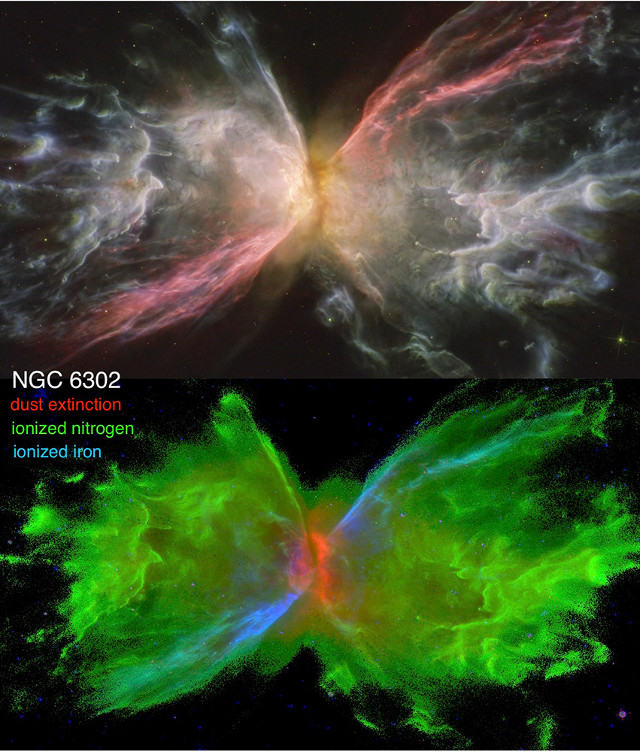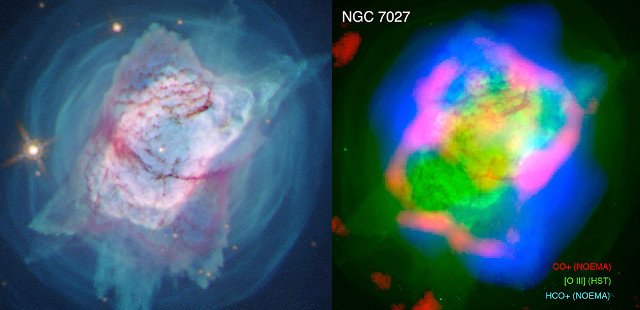
At the 237th meeting of the American Astronomical Society, new data were presented regarding the planetary nebulae NGC 6302, also known as the Butterfly Nebula, and NGC 7027, also known as the Jewel Bug Nebula. A team of researchers used observations made with the Hubble Space Telescope at different wavelengths ranging from near-ultraviolet to near-infrared to study their properties. This made it possible to obtain new details that offer new insights into the ongoing processes in which dying stars are ejecting layers of ionized gas in a chaotic way.
The agony of a star can give rise to what is called a planetary nebula due to an old misinterpretation of its nature. Today, astronomers know that this type of nebula is linked to stars and not to planets, but the name has stuck to them. The gas envelopes that make up these nebulae take on particular shapes due to chaotic processes, but it can be really difficult to examine the details because those materials can block a lot of electromagnetic emissions from the dying star.
The Hubble Space Telescope has been used on many occasions, like many other instruments, to study planetary nebulae, including NGC 6302 and NGC 7027. Most of the team who conducted this study were already studying them for quite some time, and some results were reported in an article published in the journal “Galaxies” in June 2020.
Professor Joel Kastner of the Rochester Institute of Technology stated he and his colleagues are conducting a dissection of the two planetary nebulae. Using the Hubble Space Telescope’s Wide Field Camera 3 (WFC3) instrument to its full potential made it possible to analyze images ranging from near-ultraviolet to near-infrared. Professor Kastner explained that this allowed his team to see the central star’s effects on how it’s shedding and shredding the ejected materials.
In the case of the analysis of the NGC 7027 nebula, Jesse Bublitz, a postdoc researcher at Green Bank Observatory and one of the authors of the study, extended the analysis using radio images obtained with the NOEMA (Northern Extended Millimeter Array) radio telescope. This further step allowed them to understand how ultraviolet and X-ray emissions continue to alter the chemistry in the nebula. Different regions within it are affected differently by energy emissions from the central star.
The top image (STScI, APOD/J. Schmidt; J. Kastner (RIT) et al.) shows at the top the NGC 6302 nebula as seen from the Hubble Space Telescope and at the bottom in an analysis showing various emissions of elements and molecules with their ionization. The bottom image (STScI, Alyssa Pagan; J. Bublitz (NRAO/GBO) et al.) shows the NGC 7027 nebula seen on the left by the Hubble Space Telescope and on the right in an analysis showing various molecule emissions indicating the effects of ultraviolet and X-rays.
This new analysis indicates that the NGC 6302 nebula was ejected about 2,000 years ago, so it’s very young in astronomical terms. Astronomers thought they had located the star at its center, but the analysis of images captured over the years indicates that that star is actually much closer to Earth than NGC 6302 and not connected to it. Professor Joel Kastner hopes that future studies with the James Webb Space Telescope will locate the real dying star at the center of NGC 6302.
All astronomers are hoping the James Webb Space Telescope will be successfully launched. In the meantime, the studies of the planetary nebulae NGC 6302 and NGC 7027 continue with the Hubble Space Telescope, showing their evolution, including the shock waves that are typically generated when stellar winds collide with the previously ejected gas, very useful in the reconstruction of their history. Other instruments provide observations at other wavelengths to understand the processes that take place during these stars’ aqony.


